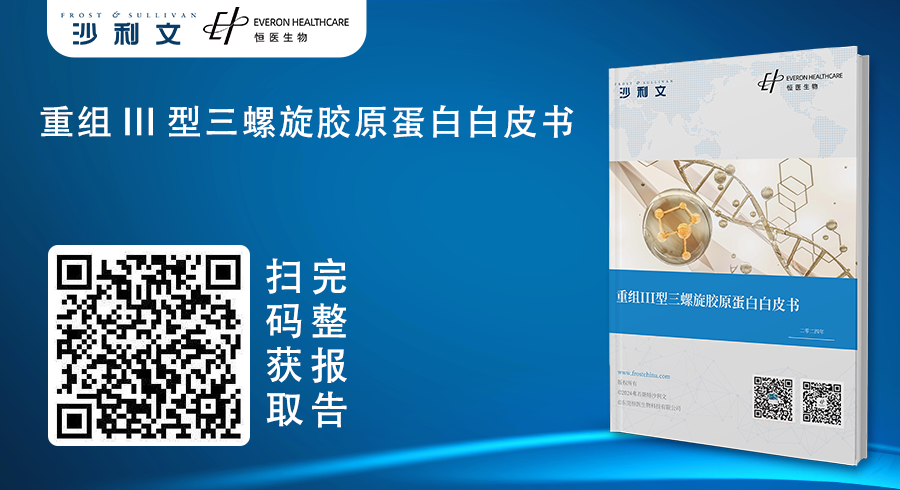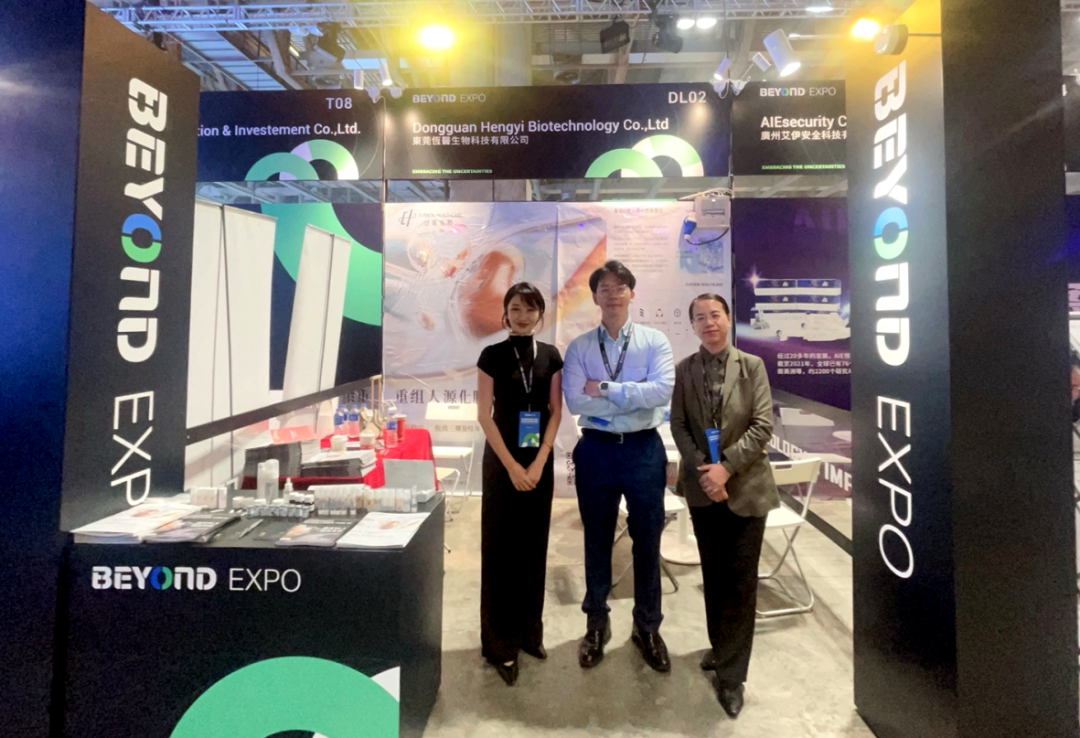 Release Time:2024-10-10 11:37:57
Release Time:2024-10-10 11:37:57
 Author:小编
Author:小编
 Views:
Views:
In recent years, biotechnology has experienced rapid development, and the emergence of new biomaterials has opened up broader application markets. Recombinant type III collagen, as a biomaterial with broad application prospects, has enormous potential in fields such as medical beauty and biomaterials due to its unique structure and function.
Traditionally, collagen is mainly extracted from animal tissues. Although collagen with a natural triple helix structure can be obtained, this method has potential safety hazards and immunogenicity issues. However, the recombinant humanized type III collagen protein developed through synthetic biology is expected to solve these problems and create more efficient, safe, and universally applicable biomaterials, further providing assistance for human health and beauty.
On September 29, 2024, Frost&Sullivan (Sullivan) and Dongguan Hengyi Biotechnology Co., Ltd. (Hengyi Biotechnology) jointly released the "White Paper on Recombinant Type III Triple Helix Collagen Protein", aiming to analyze the latest research progress, production technology, application areas, and market prospects of recombinant Type III Triple Helix Collagen protein, deeply analyze the preparation process, key technologies, and quality control standards of recombinant Type III collagen protein, and introduce its wide application scenarios in serious medical care, medical beauty, efficacy skincare, and other consumer fields. They will share relevant insights and analysis with industry followers and investors, and jointly explore the future development trends of recombinant Type III Triple Helix Collagen protein with all parties.
On September 29, 2024, the English version of the Recombinant Type III Triple Helix Collagen Whitepaper report was released on Sullivan's global website and is currently being simultaneously launched on well-known news agencies (such as Associated Press), mainstream financial media (such as Yahoo Finance), top financial media and websites in North America (such as Business Insider, Dow Jones Market Watch, Benzinga, Wall Street Insider, etc.), as well as top media in various regions around the world. With Sullivan's professional industry analysis, global promotion network, and industrial resource network, it effectively assists Chinese biopharmaceutical companies in their internationalization strategy.
Collagen, as a natural polymer protein, plays an important role in the human body. In the human body, collagen can provide structural support, participate in tissue repair, and possess hemostatic properties. Given the crucial role of collagen in human tissues and its significant advantages as a biomaterial, certain tissue engineering and biomedical materials made from collagen have achieved significant results in clinical practice and have been widely recognized by doctors and patients.
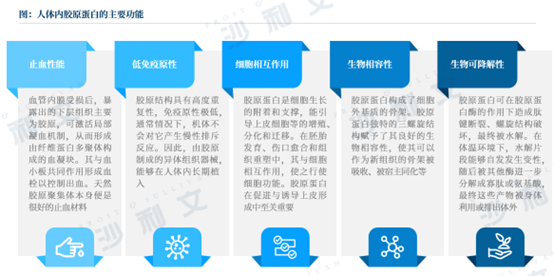
Data source: Sullivan analysis
Classification of collagen protein
From genetics to molecular structure, collagen belongs to different types of protein families. Collagen from different races and tissues has different chemical compositions or configurations. Each alpha peptide chain that makes up collagen molecules can be divided into several subtypes, and each alpha chain has a gene encoding. In theory, over 20 types of alpha peptide chains can form more than 1000 types of collagen, and so far, 28 different types of collagen have been discovered.
Introduction to Type III Collagen
Type III collagen was first identified and described by Miller et al. in 1971. Type III collagen is an extracellular matrix protein synthesized by cells in its precursor form, namely pre collagen. It exists as the main structural component in hollow organs such as large blood vessels, uterus, and intestine.
Type III collagen is synthesized as procollagen within cells. A signal peptide of 24 amino acids in length is cleaved to form a procollagen chain. Three alpha chains form a homotrimer, known as type III procollagen molecule. By using carboxy terminal (C) and amino terminal (N) proteases to remove non terminal large spherical domains, type III collagen is formed. In addition, there will be several co translations and post-translational modifications.
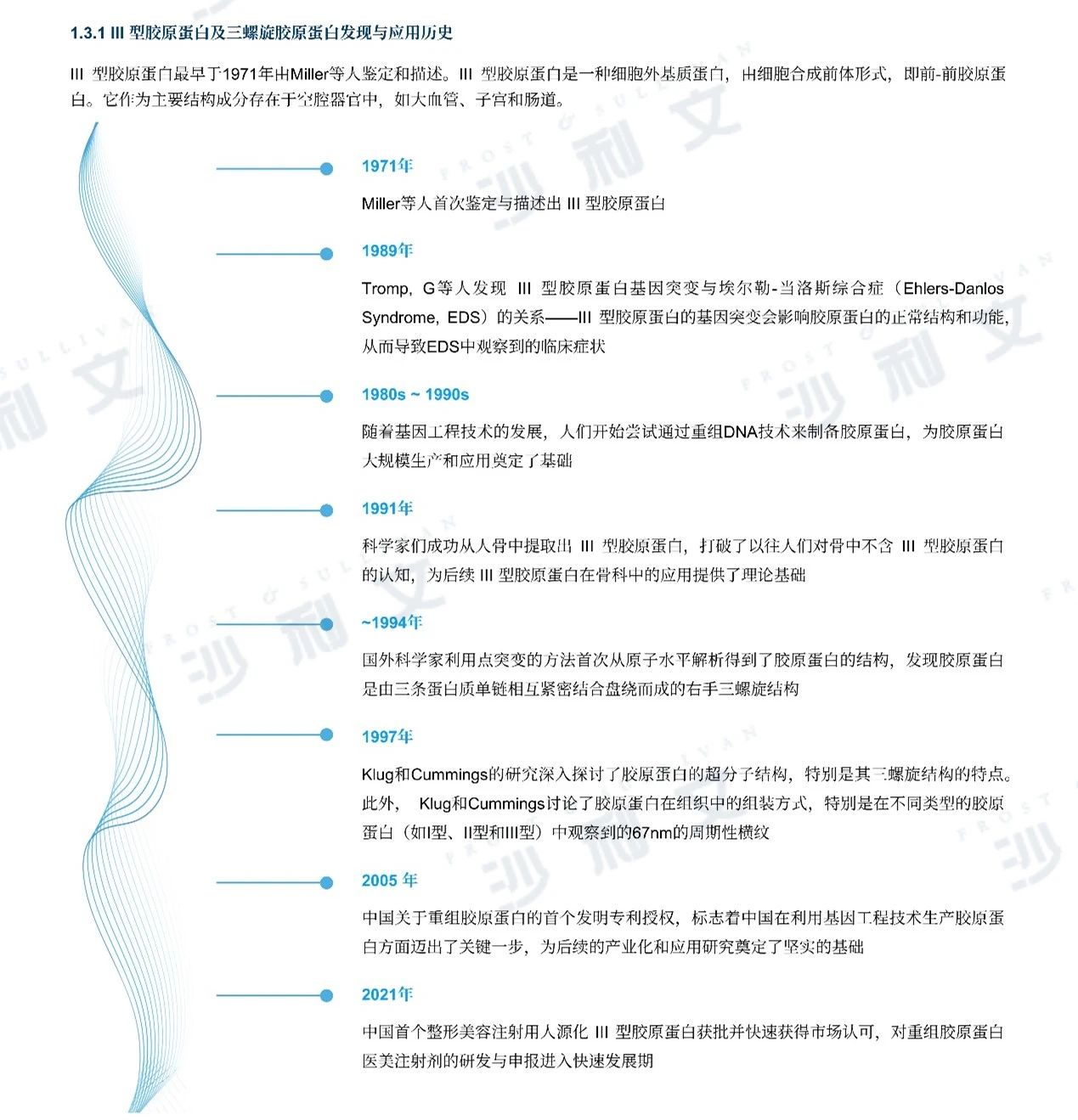
Data source: Sullivan analysis
Type III collagen is the main structural component of hollow organs such as large blood vessels, uterus, and intestines, which must be able to withstand tension. It also coexists with other types of collagen such as type I collagen in many other tissues.
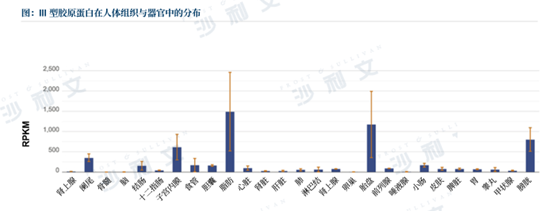
Source: Literature search, Sullivan analysis
The properties and functions of type III collagen protein
The physicochemical properties of collagen
Natural collagen is widely present in living organisms and is mainly extracted and prepared from mammals such as pigs, cows, and fish.
The performance of collagen from different sources in their application fields is largely influenced by their thermal stability. The thermal stability of collagen mainly depends on the content of proline and hydroxyproline in the molecular structure, which can form pyrrolidine rings and hydrogen bonds, thereby enhancing the stability of the molecule. With the increase of proline and hydroxyproline content in the molecule, as well as the increase of cross-linking density, the thermal stability of collagen also improves.

Source: Literature search, Sullivan analysis
The acid, alkali, and enzyme extraction methods for collagen all involve soaking in corresponding solutions for a long time to remove impurities and extract collagen, and purification treatment is required through salt precipitation and long-term dialysis. Long term exposure of collagen to alkaline, acidic, and salt chemicals may have varying degrees of impact on the chemical properties of collagen.
The function of type III collagen protein
Collagen makes up 70% of the skin's composition, and plays a crucial role in the movement of the limbs in the human body. Type III collagen is the second most abundant type of collagen in the human body, and it is a key structural component in fibrous collagen tissue.
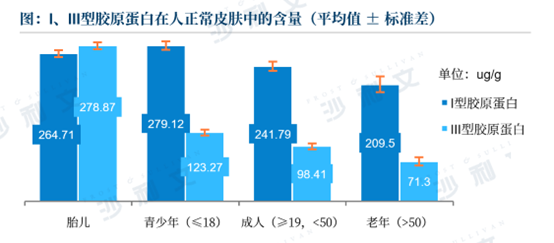
Source: Literature search, Sullivan analysis
Type III collagen mainly exists in tissues such as blood vessels, internal organs, and muscles, playing a key role in the integration and repair of extracellular matrix. It forms a large fiber network in the blood vessels, which plays a role in supporting and strengthening the blood vessel wall, maintaining its elasticity and stability, thus enabling the blood vessels to withstand the impact and pressure of blood. In addition, type III collagen plays a role in supporting and protecting the normal functioning of internal organs such as the liver, lungs, and kidneys.
Previous studies have shown that type III collagen regulates collagen fiber diameter and participates in collagen fiber cross-linking by interacting with other types of collagen. At the same time, the sequence of type III collagen contains receptor recognition sites on the cell surface, which can promote cell adhesion, migration, proliferation, and other processes through the action of integrins, and can also participate in promoting wound healing. In recent years, some studies have shown that type III collagen can maintain a dormant state of tumor cells by participating in the tumor microenvironment, thereby inhibiting tumor proliferation and having anti-tumor effects.
Type III collagen and signaling pathways
The various pathways involved in the metabolism of type III collagen intersect and interact with each other, jointly mediating the process of collagen metabolism. Protein metabolism ultimately begins with gene transcription, and generally speaking, the transcriptional activity of genes is regulated by many cis trans regulatory elements and signaling pathways composed of cytokines. In recent years, the fiber signaling pathway has attracted widespread interest. Studies have found that the self metabolism of type III collagen is regulated by signaling pathways such as NF kB, TGF - β/Smads, PI3K/Akt, ERK, and Wnt. With the deepening of research, it has been found that the various pathways involved in the metabolism of type III collagen are intertwined and mutually influenced, jointly mediating the process of collagen metabolism.
Recombinant type III triple helix collagen protein
The animal derived collagen technology is mature but there are safety hazards. Recombinant type III collagen has the advantages of high safety and stability, but the current technical threshold is high.
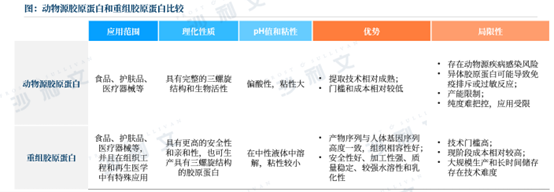
Data source: Sullivan analysis
According to the "Guidelines for Naming Recombinant Collagen Biomaterials" issued by the China National Medical Products Administration, recombinant type III collagen refers to "recombinant collagen based on the COL3A1 gene or partial gene encoding of collagen".
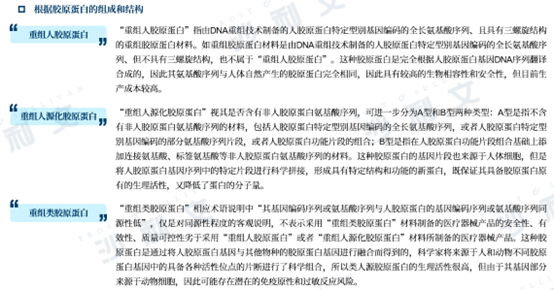
Data source: Sullivan analysis
Recombinant collagen industry standards
The formulation and implementation of policies and standards for recombinant collagen are crucial for regulating the market, guiding enterprise production, and ensuring product safety and effectiveness. China has established a series of industry standards and policy specifications for recombinant collagen raw materials and products, which detail important content such as quality control requirements, testing indicators, and testing methods for recombinant collagen.
For example, YY/T 1849-2022 "Recombinant Collagen" is a key industry standard that was released in January 2022 and officially implemented in August of the same year. In addition, YY/T 1888-2023 "Recombinant Humanized Collagen" medical device industry standard was released in January 2023 and implemented from July of the same year. These two standards cover the quality control requirements, testing indicators, and testing methods for recombinant collagen, as well as the definition, classification, inspection, labeling, use, and safety of recombinant humanized collagen. These standards apply to the quality control of recombinant collagen and recombinant humanized collagen as raw materials for medical devices. The formulation and implementation of these standards are of great significance for regulating market order, guiding enterprise production activities, and ensuring the safety and effectiveness of end products. They not only provide clear guidance for the quality control of recombinant collagen in medical device raw materials, but also encourage the research and innovation of new biomaterials, promoting the high-quality development of the medical device industry.
Preparation process and key technologies of recombinant type III collagen protein
The formation of the triple helix structure of type III collagen relies on processes such as post-translational modifications. During the design process of recombinant type III collagen, By selecting and optimizing the sequence, as well as selecting or modifying the expression system,
The successful expression of recombinant type III collagen requires control of cell lysis and purification steps, as well as evaluation of its physicochemical properties, structural characterization, thermal stability, biological functions, etc. according to national standards.
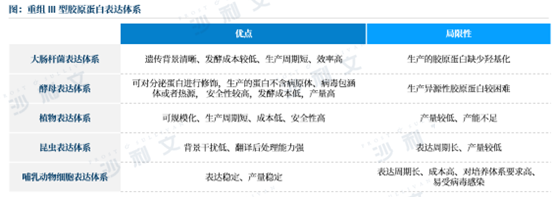
Data source: Sullivan analysis
Recombinant type III triple helix collagen has multiple characteristics and advantages
The formation of the triple helix structure of type III collagen relies on processes such as post-translational modifications. During the design process of recombinant type III collagen,
The successful expression of recombinant type III collagen requires control of cell lysis and purification steps, as well as evaluation of its physicochemical properties, structural characterization, thermal stability, biological functions, etc. according to national standards.
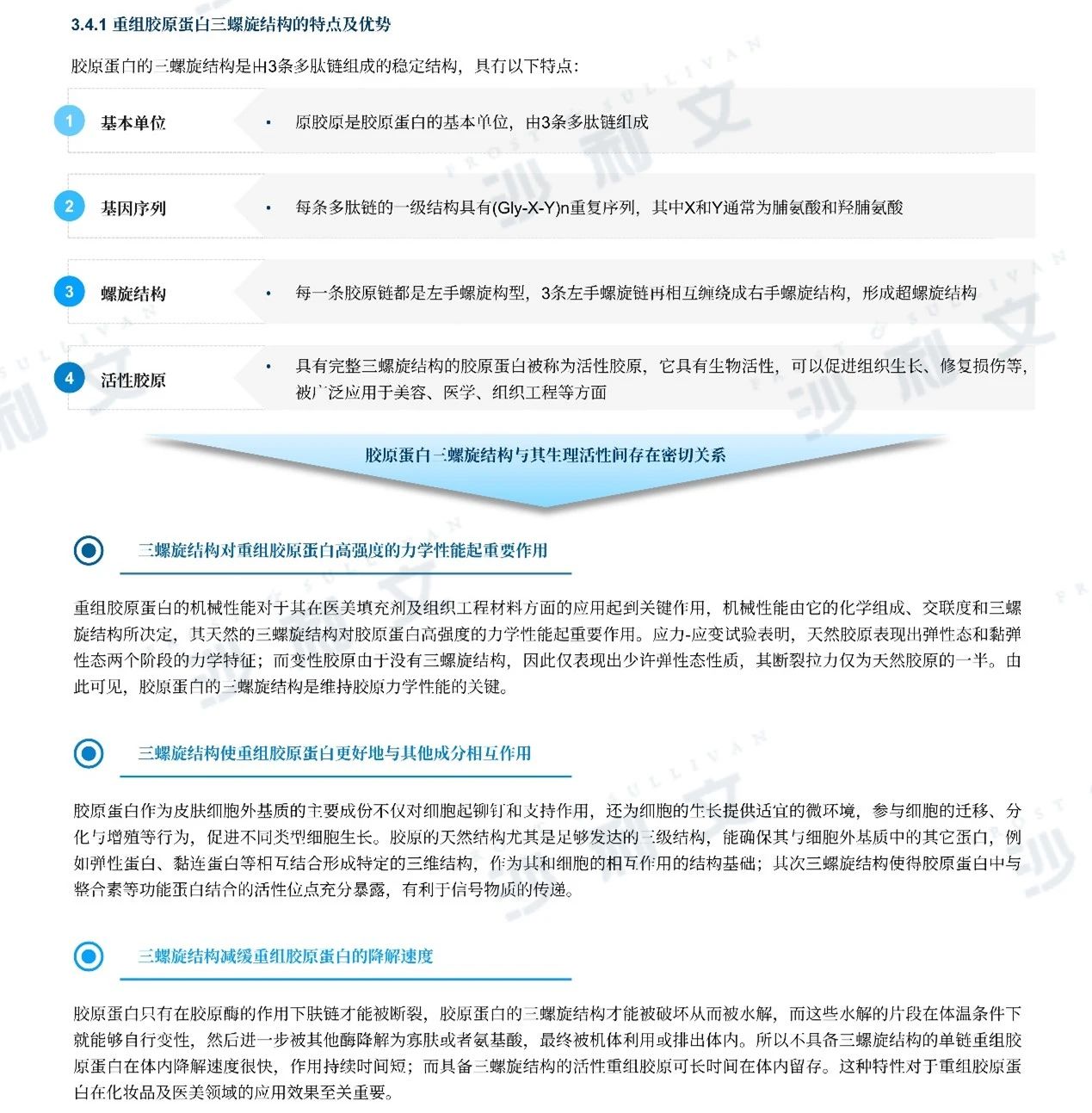
Data source: Sullivan analysis
Application of recombinant type III collagen protein
Market analysis of recombinant collagen products
Recombinant type III collagen can be applied in medical beauty, functional skincare, serious medical care, and other consumer fields. According to the official website of the State Food and Drug Administration of China, as of August 31, 2024, China has listed about 170 types of recombinant type III collagen medical devices, including scar gel, patch, ointment, repair solution and lyophilized fiber, which have been applied in fields including medical beauty injection, wound repair, scar prevention, gynecology, etc.
In recent years, the Chinese recombinant collagen market has been booming and has received strong attention from capital and consumers. The approval of three types of medical device products for recombinant type III collagen has attracted many companies to expand their production capacity and accelerate the industrialization process in this field.
Application of recombinant type III collagen protein
Recombinant type III collagen can be applied in many fields of serious medical care due to its unique properties such as biocompatibility, biodegradability, promotion of cell proliferation, and hemostatic properties. Moreover, recombinant type III collagen is widely used in the field of medical beauty, which can promote skin regeneration and repair, skin beauty and anti-aging, and can treat various skin injuries and diseases, such as burns, wounds, scars, etc. It can promote the proliferation and differentiation of skin cells, accelerate skin regeneration and repair processes, thereby enhancing the appearance and texture of the skin. Multiple clinical trials both domestically and internationally have confirmed the application value of recombinant type III collagen in medical beauty.
Collagen, as a natural moisturizing and repairing ingredient, is widely used in various cosmetic formulas. Recombinant collagen technology can select and optimize the amino acid sequence of collagen to improve its purity, exposure of integrin sites, transdermal absorption rate, and safety. In addition, recombinant collagen products are widely used in fields such as health food, hygiene products, and pet supplies, with extremely broad application prospects.
Recombinant Type III Triple Helix Collagen Excellent Enterprise Hengyi Biological Analysis
Hengyi Biotechnology is a biopharmaceutical company specializing in synthetic biology, regenerative medicine materials, and medical beauty products. It has obtained supplier qualifications from the Francis Crick Institute in the UK and is included in the global supply chain system. Hengyi Biotechnology is a subsidiary of Jinmeiji Group. As a high-tech enterprise in Guangdong Province, Jinmeiji has achieved research and development results in multiple fields after 29 years of struggle. It has established long-term close cooperation with well-known research institutes and CRO institutions to jointly explore the forefront of the biopharmaceutical industry.
Hengyi Biotechnology is one of the few leading enterprises in China that can optimize protein modification from sequence structure function aspects. It has an artificial intelligence assisted protein design platform, a high-throughput structural biology platform, a bottom strain modification platform, and a protein raw material matching screening and verification platform. The stable triple helix recombinant type III collagen developed by Hengyi Biotechnology has the characteristics of 90 ℃ high temperature recoverability, "360 °" water molecule binding force, self-assembly of quaternary structure, and excellent firming and wrinkle resistance. It is expected to further explore the application fields of recombinant type III collagen.
Hengyi Biotechnology official website:
www.everon-healthcare.com

